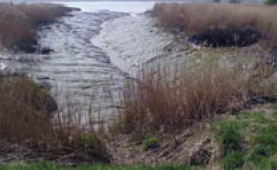



Looking After Your Finds - Reference

Member NCMD
Powered By Sispro1

Designed by Nigel G Wilcox



Copyright All Rights Reserved by Nigel G Wilcox E-Mail: ngwilcox100@gmail.com
Complimentary Topics:
Special Environments
- Wet versus dry: As a rule of thumb, keep wet objects wet, and allow damp objects to dry out slowly.
- If searching in wet environments such as riverbanks, bogs or beaches, you need to consider what other
materials you might find. Ancient and rare organic materials such as wood, leather or even textiles can
survive for thousands of years in sealed waterlogged deposits. When brought into the air attached to a
metal object, they begin to dry out and can shrink or fall apart.
- If out detecting in these environments it is often best to seal your object in a non-perforated plastic bag
straight away with a little water until you can be certain you will not be damaging something important.
- Be aware that anything found in the sea or washed ashore from tidal water must be reported to the
Receiver of Wreck (ask your local museum or FLO for details).
- Wet versus dry: As a rule of thumb, keep wet objects wet, and allow damp objects to dry out slowly.
- If searching in wet environments such as riverbanks, bogs or beaches, you need to consider what other
materials you might find. Ancient and rare organic materials such as wood, leather or even textiles can
survive for thousands of years in sealed waterlogged deposits. When brought into the air attached to a
metal object, they begin to dry out and can shrink or fall apart.
- If out detecting in these environments it is often best to seal your object in a non-perforated plastic bag
straight away with a little water until you can be certain you will not be damaging something important.
- Be aware that anything found in the sea or washed ashore from tidal water must be reported to the
Receiver of Wreck (ask your local museum or FLO for details).
Conservation Advice
On site: Recording and Lifting Finds
To get maximum information from your finds it is important that they are lifted and recorded properly.
- What have I found?
- Is it an isolated find or part of a larger group? Metal finds may be associated with other objects or
materials.
- Removing finds from the plough-soil does not usually disturb the archaeological layers below, but on
unploughed land the archaeology can lie close to the surface.
- Be responsible when choosing where to detect. If you think you have located a previously undiscovered
archaeological find beneath the plough-soil, tell the landowner and your Finds Liaison Officer (FLO). The
FLO can help to assess the site and (if necessary) can call in an archaeologist to help you dig, lift and
record the finds.
- It's best to leave any unwanted finds where you found them.
On site: Recording and Lifting Finds
To get maximum information from your finds it is important that they are lifted and recorded properly.
- What have I found?
- Is it an isolated find or part of a larger group? Metal finds may be associated with other objects or
materials.
- Removing finds from the plough-soil does not usually disturb the archaeological layers below, but on
unploughed land the archaeology can lie close to the surface.
- Be responsible when choosing where to detect. If you think you have located a previously undiscovered
archaeological find beneath the plough-soil, tell the landowner and your Finds Liaison Officer (FLO). The
FLO can help to assess the site and (if necessary) can call in an archaeologist to help you dig, lift and
record the finds.
- It's best to leave any unwanted finds where you found them.
Where was it found?
The location in which archaeological finds are discovered is just as important as the objects themselves.
- Having recorded your find spot on the bag, you can relate that to the National Grid Reference (see our
guide to this for instructions, or ask your FLO to explain how to do this). Some people now use a hand-
held GPS (global positioning system) as a fast way to record find-spot location.
- It is a good idea to transfer your readings to hard copy such as a map, or a computer database later on.
- You may also want to photograph your finds in the ground with a ruler or scale, or photograph the find-
spot.
- Remember: part of caring for your finds is conserving the information about them for future generations.
The location in which archaeological finds are discovered is just as important as the objects themselves.
- Having recorded your find spot on the bag, you can relate that to the National Grid Reference (see our
guide to this for instructions, or ask your FLO to explain how to do this). Some people now use a hand-
held GPS (global positioning system) as a fast way to record find-spot location.
- It is a good idea to transfer your readings to hard copy such as a map, or a computer database later on.
- You may also want to photograph your finds in the ground with a ruler or scale, or photograph the find-
spot.
- Remember: part of caring for your finds is conserving the information about them for future generations.
Bagging and Labelling
- Once you have found something you want to keep, place it in a plastic bag. Polythene griptop bags
with white strips are best. Your FLO can tell you where to get hold of these.
- You can write the find spot and any other information you want directly onto the bag. Labelling your bags
is important if you want the information about your finds to last.
- Permanent black marker pens for bag marking (e.g. Artline pens) will not fade over time.
- Always bag finds individually for protection and to stop them getting mixed up. It is a good idea to punch
small holes in the bags to provide ventilation and stop harmful condensation from forming.
- Remember, if you are tempted to clean your finds in the field, you risk causing damage, lowering the
amount of information they can give us about our past, and reducing any financial value.
- Once you have found something you want to keep, place it in a plastic bag. Polythene griptop bags
with white strips are best. Your FLO can tell you where to get hold of these.
- You can write the find spot and any other information you want directly onto the bag. Labelling your bags
is important if you want the information about your finds to last.
- Permanent black marker pens for bag marking (e.g. Artline pens) will not fade over time.
- Always bag finds individually for protection and to stop them getting mixed up. It is a good idea to punch
small holes in the bags to provide ventilation and stop harmful condensation from forming.
- Remember, if you are tempted to clean your finds in the field, you risk causing damage, lowering the
amount of information they can give us about our past, and reducing any financial value.
Out of your Depth?
- Most of the time you will come across single isolated items and in these cases digging up and
recording your find is often simple. However, you may be lucky enough to find a large group of objects
of significant archaeological importance. These groups can often be complex or fragile and are easily
damaged if lifted without special equipment and training. Archaeologists often call in a conservator to
help with recording and lifting in these cases.
- If you are unsure of what you have uncovered, contact your FLO for help.
- You might want to take a photograph of the objects in the ground, then cover the object, for example
with a plastic bag to act as a marker and refill the hole whilst you wait for help. Don’t forget to record
the find-spot though!
- Most of the time you will come across single isolated items and in these cases digging up and
recording your find is often simple. However, you may be lucky enough to find a large group of objects
of significant archaeological importance. These groups can often be complex or fragile and are easily
damaged if lifted without special equipment and training. Archaeologists often call in a conservator to
help with recording and lifting in these cases.
- If you are unsure of what you have uncovered, contact your FLO for help.
- You might want to take a photograph of the objects in the ground, then cover the object, for example
with a plastic bag to act as a marker and refill the hole whilst you wait for help. Don’t forget to record
the find-spot though!
The Paragon Of Metal Detecting
& Archaeology
& Archaeology
Pages

Reference Menu




















